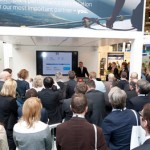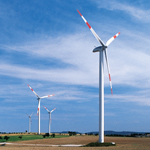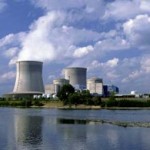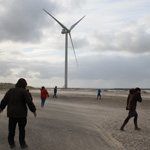 In just over three months’ time thousands of wind energy professionals will gather in Vienna alongside EU and national level decision makers, financeers, technology specialists and others at the European Wind Energy Association’s Annual Event, EWEA 2013.
In just over three months’ time thousands of wind energy professionals will gather in Vienna alongside EU and national level decision makers, financeers, technology specialists and others at the European Wind Energy Association’s Annual Event, EWEA 2013.
But what will everybody be talking about at the event? Yesterday, I spoke to some of the conference’s lead session chairs to get a glimpse of just one of the topics that will make Vienna buzz next February…
Turbine technology – just how big can turbines get? Now that the 5 MW barrier has been broken, what’s the next step? While some said the “sky is the limit” others pointed to practicalities like the ability to transport large turbine components, especially offshore. No vessel in the world has yet been designed to transport the largest of turbines one insider told me. Others noted that onshore, turbine size probably wouldn’t get much bigger due to possible public acceptance issues.
 Aviation constraints are a huge issue for the wind industry. In 2011, EWEA carried out a survey and found that 19 GW of wind projects were blocked by radar difficulties in the UK, Finland, Sweden, Germany, Czech Republic, France, Spain, Greece and Ireland.
Aviation constraints are a huge issue for the wind industry. In 2011, EWEA carried out a survey and found that 19 GW of wind projects were blocked by radar difficulties in the UK, Finland, Sweden, Germany, Czech Republic, France, Spain, Greece and Ireland.
Many difficulties for wind farm developers come from conflicts with obsolete radar equipment and problems associated with keeping track of system upgrades over time. According to Renewable UK, for example, half of all wind farm developments in the UK will face objections from aviation stakeholders on the grounds of radar interference, obstruction or impact to low flying. However, a new promising radar technology could be one way to solve some of these problems.
Cambridge Airport in the south-east of England has signed a deal to use so-called 3D holographic radar technology. Its creators claim that the technology is the first of its kind that can reliably discriminate between wind turbines and aircraft based on differences in their behaviour.
 Extending or ending the US’s Production Tax Credit is a topic high in the minds of wind industry professionals with interests in the US, but how is it reported in US media?
Extending or ending the US’s Production Tax Credit is a topic high in the minds of wind industry professionals with interests in the US, but how is it reported in US media?
Interestingly, an increasing number of US newspapers support an extended PTC. Here, we round-up some of the latest articles…
In San Angelo,Texas the Standard-Times said, “give the wind industry some certainty, and then stand back and watch the turbines spin.” In an editorial on Saturday the newspaper noted the tax credit of 2.2 cents per kilowatt-hour is set to expire at the end of the year unless Congress renews it. “Few disagree that failing to extend it will cause great harm to the industry just as it is beginning to flourish,” the newspaper lobbied.
 The nuclear industry’s ‘Foratom’ blog recently criticised EWEA’s argument in a recent report that “massive subsidies to fossil fuels and nuclear energy…. remain the rule”.
The nuclear industry’s ‘Foratom’ blog recently criticised EWEA’s argument in a recent report that “massive subsidies to fossil fuels and nuclear energy…. remain the rule”.
Foratom instead claimed that “it is renewable energies, especially wind and solar energy that are the most systematically subsidised forms of energy, not nuclear energy.”
Foratom then set out some of the subsidies renewables receive. The highest figure they quote is “In Germany, total subsidies amount to €5 billion per year”.
But Foratom does not mention the massive amounts of public money set aside for nuclear decommissioning. €5 billion is a trivial sum compared to the money the UK Government has set aside just for nuclear decommissioning.
Former UK Energy Secretary Chris Huhne said in October 2011 “the provisions for nuclear decommissioning costs in total were £2 million in 1970, £472 million in 1980, £9.5 billion in 1990, £22.5 billion in 2000. And now, £53.7 billion.”
 By Fiona Woo, World Future Council
By Fiona Woo, World Future Council
Winds of 60 km per hour hit us as soon as we alighted from the bus at Hvide Sande – “White Sand” – on the west coast of Denmark, home to a community-owned wind energy project comprising three 3MW turbines. All that could be heard was the powerful wind: the generators cannot be heard over the considerable sound of the wind.
I was joined by 40 policy makers and experts from 15 European countries as part of a workshop on 100% Renewable Energy in European Regions, organised by the World Future Council and the Climate Service Center at the Nordic Folkecenter, Denmark. The region serves as a living example of 100% renewable energy already in action. Wind plays a big role in this area of Europe: 87% of the country’s electricity consumption that day was covered by wind power, and, in Denmark as a whole, €16 million from local residents is being invested in renewable energies.
 In just over three months’ time thousands of wind energy professionals will gather in Vienna alongside EU and national level decision makers, financeers, technology specialists and others at the European Wind Energy Association’s Annual Event, EWEA 2013.
In just over three months’ time thousands of wind energy professionals will gather in Vienna alongside EU and national level decision makers, financeers, technology specialists and others at the European Wind Energy Association’s Annual Event, EWEA 2013.






 Comments
Comments



